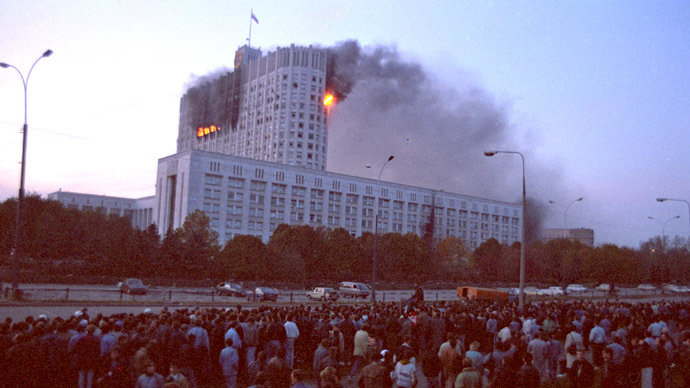
Satter wrote:
"The first unexamined episode was the massacre at the Ostankino television tower in 1993, in the wake of Boris Yeltsin's illegal order abolishing the Russian parliament. Thousands of unarmed pro-parliament protesters near the tower were fired on with automatic weapons, leaving 46 dead and 124 wounded. Yeltsin then persuaded the army to attack the parliament building and, in the wake of military victory, introduced a super-presidency with near-dictatorial powers.Let's take the four elements in Satter's compound distortion one at a time.
With no check on executive power, Yeltsin launched the first Chechen war in 1994 and facilitated the widespread corruption that drove Russia into poverty and hardship" (David Satter, "The Russian State of Murder under Putin," Wall Street Journal, 21 January 2016).
Satter 1: "The first unexamined episode was the massacre at the Ostankino television tower in 1993, in the wake of Boris Yeltsin's illegal order abolishing the Russian parliament. Thousands of unarmed pro-parliament protesters near the tower were fired on with automatic weapons, leaving 46 dead and 124 wounded."FACT 1: The two sentences are written so that readers infer that forces loyal to Yeltsin shot unarmed pro-parliament demonstrators. I was in Moscow and witnessed these events as they were broadcast on Russian television, and videos are readily available on the Internet today. In fact, before, during and after failed negotiations between the Kremlin and the parliamentary Duma, the parliament began accepting into its corridors armed neo-fascist and radical communist groups and stockpiling weapons and ammunition. These elements then attacked and seized the Moscow mayor's offices next door, killing several and wounding many more. They then proceeded in the hundreds on buses, trucks and cars across Moscow to Ostankino where they stormed and temporarily succeeded in taking over the television broadcast tower, studios, and offices at Ostankino. Led by elements tied to radical Stalinist Viktor Anpilov's and General Albert Makashov's Russian Communist Workers' Party and other extremist forces, these armed thugs drove their vehicles through the front glass doors and windows of the first floor and stormed the building. Others fired on the building through the night, and armed guards and arriving police returned fire. There were casualties on both sides.
Satter 2: "Yeltsin then persuaded the army to attack the parliament building."FACT 3: This occurred after the violent attacks mentioned above and others undertaken by the so-called 'red-brown opposition' and the failure of negotiations - the key context that Satter is careful to leave out of his wholly inaccurate account. Yeltsin with great difficulty managed to convince a very few commanders to contribute limited military forces to put down the myatezh or rebellion.
Satter 3: Yeltsin "introduced a super-presidency with near-dictatorial powers."FACT 3: Yeltsin's powers under the December 1993 constitution were far from 'dictatorial'. Under the new Russian constitution: (1) there was considerable separation of executive, legislative and judicial power; (2) there was highly decentralized, hyper-federative, treaty-based system regarding relations between the federal and regional governments such that by the end of Yeltsin's rule thousands of regional laws, decrees, and constitional clauses violated the federal laws and constitution; (3) the media were completely independent; party politics was intensely competitive, wide-open and free; and (4) like today, protests, including violent ones were frequent, nearly daily occurrences in Russia. Yeltsin often had great difficulty in getting his nominees for government positions, including for the position of prime minister approved by the parliament, and could not get legislation through parliament without negotiations and even then Kremlin legislation was often defeated.
Satter 4: "With no check on executive power, Yeltsin launched the first Chechen war in 1994 and facilitated the widespread corruption that drove Russia into poverty and hardship."FACT 4: Satter carefully leaves out of this description the fact that a violent, extremist, ultra-nationalist groups of Chechens had illegally seized power in Chechnya in 1991, and Chechen President Dzhokhar Dudaev had established a dictatorial system that nevertheless was descending into chaos and violence. Unlike the Maidan Ukraine regime in April 2014, Yeltsin waited and negotiated with these extremists for three years before beginning his anti-terrorist operation in Chechnya. The Western-backed regime in Kiev waited a few weeks when faced with a similar situation—illegal seizure of power by Donbass rebels, minus the Chechen chaos and violence—and engaged in virtually no real negotiations with its rebels in the Donbass.



I thought Sott's stance was that Yeltsin was very, very bad? I know one thing - Yeltsin was good for Eastern Europe and much loved there.